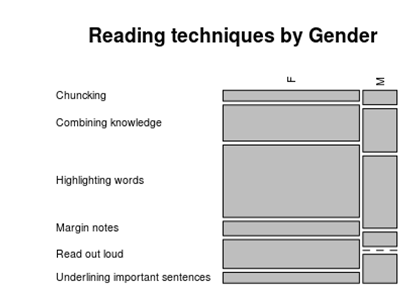|
Size: 789
Comment:
|
Size: 2858
Comment:
|
| Deletions are marked like this. | Additions are marked like this. |
| Line 2: | Line 2: |
| = Definition of Metacognition = | = Metacognition of reading = == Definition of Metacognition == |
| Line 8: | Line 9: |
| According to some studies (Brown Campione and Day,1981/ Flavell and Wellman,1977) there are four variables in the metacognition of reading: | So, it refers to both the knowledge and the control over your own thinking and learning, an awareness and understanding of one’s own thought processes |
| Line 10: | Line 11: |
| 1. The text – features of the material that has to be learned (difficulty,familiarity,interest..etc) 1. The task – the act of memorizing by the reader. 1. The strategies- which we will discuss later on. 1. The learner's characteristics- ability,motivation. 1. |
According to some studies there are four variables in the metacognition of reading: (Brown Campione and Day,1981/ Flavell and Wellman,1977) 1. __The text__ – features of the material that has to be learned (difficulty,familiarity,interest..etc) 1. __The task__ – the act of memorizing by the reader. 1. __The strategies__- which we will discuss later on. 1. __The learner's characteristics__- ability,motivation The metacognitive strategies of learning/reading involve processes such as: * '''__Planning__''': assessing knowledge before reading : What don’t I know? What do I need from this text ? * '''__Monitoring:__''' literal reading isn’t enough, connections have to be made in between prior knowledge and the read text: Do I understand what I just read ? We thereby determine whether that new information is relevant or not * '''__Summarizing/Evaluating:__''' Is what I am doing working? |
| Line 17: | Line 25: |
| === Metacognition of reading and the brain === | We can differentiate various '''reading''' '''strategies''': (Pressley & Afflerbach-1995) a. overview before reading (chuncking/pre-segmenting the reading time) a. look for important information and pay greater attention to it (highlighting words) a. relate important points to one another a. activate and use prior knowledge(combining knowledge) a. change strategies when understanding is not good (read out loud...) a. monitor understanding and take action to correct inaccuracies in comprehension.(margin notes) Studies show that unsuccessful students lack this strategic approach to reading (Garcia, Jimenez, & Pearson, 1998). It was also found that dyslexic readers (poor text comprehension and spelling abilities) frequently use metacognitive strategies as a compensation to try and understand the text better (Kirby et al.2008). __Those reading techniques can be studied statistically:__ For this, we took a population of 60 individuals (48 Women; 12 Men), all second year veterinary students. This ratio of 80%/20% can be considered representative of the class (which is our 'population' here). Throughout a poll, we collected data concerning the main reading techniques. The frequency proportions of reading techniques (in each gender) are displayed in the following Mosaicplot: {{attachment:Mosaicplot.png| |width=100 height=150}} == Metacognition of reading and the brain == |
Metacognition of reading
Definition of Metacognition
First of all, what is metacognition?
- To put it in a simple way it means « thinking about thinking » (Anderson, 2002)
- According to Byrd, Carter, and Waddoups (2001), it is self-awareness of mental process.
So, it refers to both the knowledge and the control over your own thinking and learning, an awareness and understanding of one’s own thought processes
According to some studies there are four variables in the metacognition of reading: (Brown Campione and Day,1981/ Flavell and Wellman,1977)
The text – features of the material that has to be learned (difficulty,familiarity,interest..etc)
The task – the act of memorizing by the reader.
The strategies- which we will discuss later on.
The learner's characteristics- ability,motivation
The metacognitive strategies of learning/reading involve processes such as:
Planning: assessing knowledge before reading : What don’t I know? What do I need from this text ?
Monitoring: literal reading isn’t enough, connections have to be made in between prior knowledge and the read text: Do I understand what I just read ? We thereby determine whether that new information is relevant or not
Summarizing/Evaluating: Is what I am doing working?
Reading strategies
We can differentiate various reading strategies: (Pressley & Afflerbach-1995)
- overview before reading (chuncking/pre-segmenting the reading time)
- look for important information and pay greater attention to it (highlighting words)
- relate important points to one another
- activate and use prior knowledge(combining knowledge)
- change strategies when understanding is not good (read out loud...)
- monitor understanding and take action to correct inaccuracies in comprehension.(margin notes)
Studies show that unsuccessful students lack this strategic approach to reading (Garcia, Jimenez, & Pearson, 1998).
It was also found that dyslexic readers (poor text comprehension and spelling abilities) frequently use metacognitive strategies as a compensation to try and understand the text better (Kirby et al.2008).
Those reading techniques can be studied statistically:
For this, we took a population of 60 individuals (48 Women; 12 Men), all second year veterinary students. This ratio of 80%/20% can be considered representative of the class (which is our 'population' here).
Throughout a poll, we collected data concerning the main reading techniques. The frequency proportions of reading techniques (in each gender) are displayed in the following Mosaicplot:

